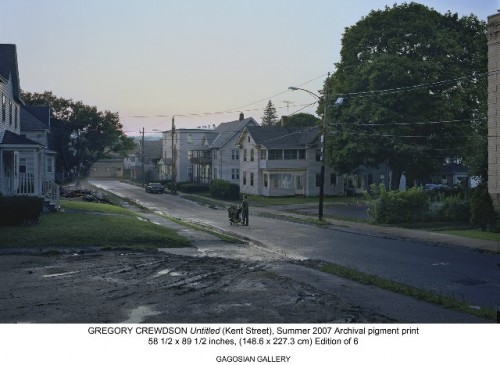Untitled by Gregory Crewdson at Montserrat
MCA Commencement Exhibition
By: Shawn Hill - May 12, 2012
untitled
Gregory Crewdson
Commencement Exhibition
Carol Schlosberg Alumni Gallery
May 7-25, 2012
Montserrat College of Art
Beverly, MA
Gregory Crewdson offers work from two different series in this spare and powerful show: A harrowing archival pigment print of an American neighborhood, and two black and white works related to the Italian cinema industry.
The full-color work has a subtitle, (Kent Street), and at first all seems calm. Amidst suburban houses and trees on a not very cold late afternoon, a man pushes a shopping cart down the street, heading west towards the sunset. Crewdson's technique involves not having a central focal point, so that every inch of the surface receives equal detail and development. And it is in those details that we start to notice what is amiss.
The man, in worn shoes and faded jeans, is pushing a stolen cart full of debris. This random assortment of goods is all salvage; an old TV, a shade-less floor lamp, folded rugs and battered paintings comprise his treasures. Is he on the prowl for more, though his cart is full? Where is he coming from, and where is he going, as he rolls down the center of the empty street?
Around him, though their gardens are prim and cut, things have gone wrong at some of the dwellings. A few yards ahead, there's no house at all, but a lot filled with crudely stacked boards and shingles. To his right, windows have been covered with plastic, and further along another house is boarded up on the porch, but a blasted hole in the siding has been left to expose the second story to the elements.
The composition renders this figure at its center miniscule and impotent. Some apocalypse has already occurred, and there will be no recovery. The camera is as interested in the muddy and abstract tangle of tire tracks in the foreground as it is in any other sign of human activity in this desolate world.
The black and white images of studio back lots, taken in Italy, have a modicum more romanticism, but are also unbearably lonely and bereft of human presence. One can read the European influence clearly, as these half-finished dwellings and facades refer to millennia-old ways of life. There's none of the fun and rickety shanty-town look you might think of for American westerns, or even the gritty urban settings needed for films noir. These false streets refer to villages, churches, pensions and mercantile plazas, as settings for an endlessly unspooling human drama. Only, with no actors, no direction, no sense of purpose, the streets and doorways become empty and echoing passages to nowhere. Endlessly present, they ironically have no starting point or finish line in sight. Crewdson's photographic gift is profound: He knows where to find limbo.




